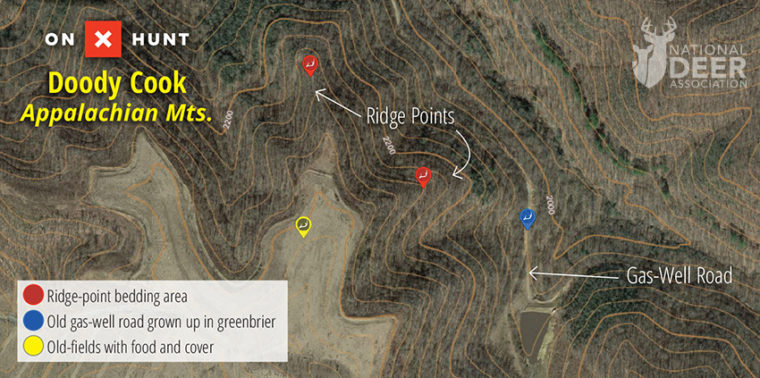I had never read a comprehensive article with shed-hunting strategies for specific regions of the whitetail’s range. So, I wrote one! I interviewed six shed-hunting nuts from the Midwest, Mississippi River Valley, Deep South, Appalachian Mountains, Northeast, and the Northern Great Plains. Let’s look at what Doody Cook of West Virginia had to say about shed hunting the Appalachian Mountains.
NDA members read my article in Quality Whitetails magazine in 2020. Now, NDA is going to share my article free online, in six parts. To be notified as each part is released, sign up for NDA’s free e-newsletter here.
Each installment of this series is accompanied by a map from the onX Hunt app in that region, showing actual terrain examples you should look for.
Doody Cook – West Virginia
Southern West Virginia is smack in the middle of Appalachian Mountain coal country with millions of acres of forest. This can make shed hunting difficult as you attempt to locate antlers in a large monotonous landscape. Doody Cook, however, is a 14-year Appalachian shed-hunting veteran who consistently finds huge sheds.
Doody shed-hunts every spring day he can, covering up to 10 miles a day in extremely steep hills and hollers. He puts a lot of time into pre-season scouting, which for him means driving roads, glassing hills, and running trail-cameras to locate potential target bucks come shedding season.
When it’s time to hit the woods, Doody concentrates on bedding areas and natural food sources. He likes to glass and walk old fields created from strip-mine reclamation. Doody will sit on a high point overlooking these fields and glass them for visible sheds, then walk the thicker blackberry and greenbrier patches. He also walks edges of ponds in these fields, concentrating on sites where deer drink and heavy trails leading to the water.
Hardwood ridges are also an integral part of Doody’s strategy. He likes to walk the main spine of a ridge then drop down and search points of spurs jutting off the ridge. He has picked up countless sheds on these points where mature bucks seem to like bedding. Thickets of greenbrier, rhododendron or mountain laurel sweeten a ridge point even more because they provide cover and/or natural winter food, concentrating bucks post-rut. Doody also finds great success walking old logging and gas-well roads that have grown up in greenbrier and other brambles.
Next week, we’ll head to the Northeast with Ray Purdy of New York. Stay tuned, and remember to sign up for NDA’s e-newsletter to get all of NDA’s deer hunting content as soon as it’s available.

